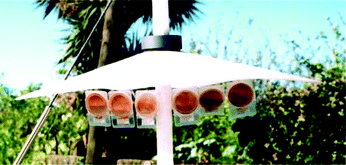The ability of biological and organic synthetic materials to accumulate atmospheric particulates containing copper, lead, nickel and strontium†
Abstract
This work was aimed at finding materials that could be used as alternatives to lichens as air quality monitors since the high natural variability and the large amount of lichen collected are two drawbacks of the use of these organisms. Lichen Flavoparmelia caperata (L.) Hale was exposed in three different forms (transplant, detached from the substratum and as a biomass—ground and homogeneized) and compared to the planetree bark (Platanus hybrida Brot.), exposed as a biomass, and two organic synthetic materials (Chelex® 100 resin and cellulose acetate). Materials were exposed for two months in the winter, spring and summer, at three Portuguese coastal cities. The results showed that the airborne accumulations of Cu, Ni, Pb and Sr were partially dependent on the meteorological conditions but mainly dependent on the nature of the exposed material. The standard deviations of the synthetic materials or homogenized biomass were the same or greater than lichen transplants or detached. The accumulation by biological materials, of the four studied elements, was comparable to the lichen transplant accumulation. The replacement of the traditional transplants by the biomass was not considered advantageous, since their preparation is time-consuming. Therefore lichens remain the most suitable in biomonitoring studies. The exposure of detached lichen allows the accurate measurement of the exposed area/volume so it can be useful to relate atmospheric deposition rates with the lichen metal content. The synthetic materials accumulated Cu and Ni and should only be used as an alternative to traditional transplants when these are the elements of interest.


 Please wait while we load your content...
Please wait while we load your content...